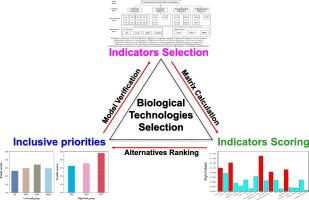Science of the Total Environment ( IF 9.8 ) Pub Date : 2020-06-20 , DOI: 10.1016/j.scitotenv.2020.140400 Cong Wei 1 , Jingyue Wei 2 , Qiaoping Kong 1 , Dan Fan 1 , Guanglei Qiu 1 , Chunhua Feng 1 , Fusheng Li 2 , Sergei Preis 3 , Chaohai Wei 1

|
The design of biological treatment process for the coking wastewater (CW) is complicated since wastewater treatment demand is gradually increasing lacking the systematic strategy in efficiency evaluation and advisable selection. Therefore, this study develops a holistic approach by means of the analytic hierarchy process (AHP) that uses numerical representation to rank the preferences of each participating alternatives for evaluation of the advanced biological technologies in CW treatment. Based on survey results, six types reactor combinations were selected as the alternatives, which were further classified as two group according to COD load. The AHP methodology consists of weighting and ranking procedures considering technical, economic, environmental and administration factors defined as criteria layers. Eighteen indicators were chosen as sub-criteria layers. Inclusively beneficial and sustainable biological processes were assessed and ranked along the AHP implementation. The results placed technical indicators to the top position among the criteria layers in the weighting descending order ‘technical indicators > economic indicators > environmental indicators > administrative indicators’, whereas the weight of indicators in sub-criteria layers fitted in the range of 0.005 to 0.151. The inclusive priority calculation integrating all weight indices of criteria and sub-criteria layers resulted in the anaerobic-anoxic-oxic (A/A/O) combination rising in the hierarchy of the low load group, whereas the oxic-hydrolytic-oxic (O/H/O) process was prioritized in the high load group. The accuracy and objectivity of AHP application was also supported by sensitivity and variability analyses that examines a range for the weights' values and corresponding to alternative scenarios.
中文翻译:

层次分析法选择焦化废水最佳生物处理方法。
焦化废水(CW)的生物处理工艺设计复杂,因为废水处理需求逐渐增加,但缺乏效率评估和明智选择的系统策略。因此,本研究通过层次分析法(AHP)开发了一种整体方法,该方法使用数值表示来对每种参与方案的偏好进行排序,以评估CW治疗中的先进生物技术。根据调查结果,选择了六种反应器组合作为替代方案,根据COD负荷将其进一步分为两组。AHP方法包括加权和排名程序,其中考虑了定义为标准层的技术,经济,环境和管理因素。选择了18个指标作为子标准层。在AHP实施过程中,对包容性有益和可持续的生物过程进行了评估和排名。结果将技术指标放在权重降序“技术指标>经济指标>环境指标>行政指标”中的标准层中的最高位置,而子标准层中指标的权重在0.005到0.151之间。包含优先级和子标准层的所有权重指数的优先级包含在内的计算结果导致低负荷组中厌氧-缺氧-氧化(A / A / O)组合增加,而氧化-水解-氧化(O / O / H / O)处理在高负载组中被优先处理。


























 京公网安备 11010802027423号
京公网安备 11010802027423号